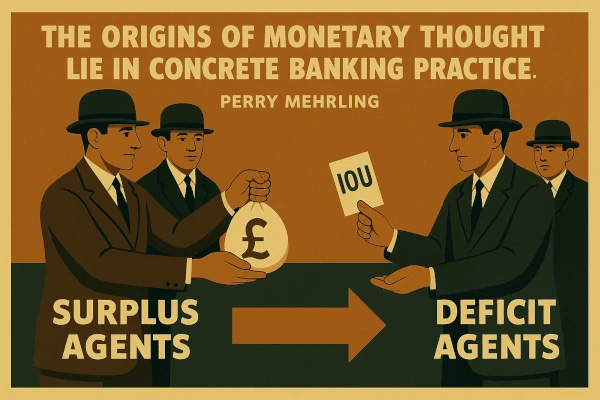1:1 The Money Market
Smoothing Over Payments Deficits
When I first started Perry Mehrling's Economics of Money and Banking course (2012), I had no clue about the money market. What does it mean for there to be a market for money?
The money market is where banks and other institutions temporarily borrow large amounts of money from each other to satisfy their survival constraints and make their promised payments. Deficit agents—those with more outgoing than incoming payments—cover their shortfalls by borrowing extra cash from surplus agents.
The money market is a wholesale market for low-risk, highly liquid, short-term IOUs.
(Stigum and Crescenzi 2007, 1)
The money market is a short-term funding-liquidity market.1 You can get money today2 by promising to pay more money tomorrow.3 The difference—the interest rate—is the price you pay.
Everyone has their own individual balance of payments: the time pattern of locked-in cash flows and cash commitments.4 When money is tighter in the market as a whole, those with payments deficits drive up the money rate of interest by bidding for funds.5
The state of the money markets … gives information about the coherence of the system as a whole. Are people in general able to meet their cash commitments with the cash flows that are coming in to them, or are they in general trying to put off the day of reckoning to another later day? The money market is a sensitive barometer, telling everyone the current state of the system to which they are trying to adapt their own behavior.
(Mehrling 2012a, 6)
Mehrling (2012) relies on Stigum's Money Market (Stigum and Crescenzi 2007) and the Financial Times for real-world descriptions of the money market.
Clip Length 5:12 (2012 Lec 1:1, 4:57–10:09)
Think of yourself as an anthropologist reading the sacred text of some tribe, maybe primitive tribe, and trying to figure them out—how they think about the world, and so forth. I'm not trying to teach you to trade the money markets—not at all. But we are trying to understand this world that's really rather arcane—rather special. And the people who live in that world are interviewed in here. So this is our sort of window into the operations of this strange tribe.
(Lec 1:1, 5:57)
The survival constraint6 naturally gives rise to the money market that eases it. That's why the money market features so heavily in practical banking.
We start not so much with the tools of economics but rather with the testimony of practical bankers themselves, whose business requires them to work out the implications of a changing world for their own practice. One thing that my historical studies have taught me is that the origins of monetary thought lie in concrete banking practice.
(Lec 1 Notes, 1)
This course7 is about building a theory of money that's grounded in the realities of the survival constraint and the money market. Stigum and the Financial Times help provide that grounding.
References
Howlett, Alex. 2025a. "Settle or Die: Payment, Liquidity, and Survival." The Survival Constraint (blog). February 9. https://survivalconstraint.substack.com/p/settle-or-die.
Howlett, Alex. 2025b. "Balancing Act: Lining Up Cash Flows in Time." The Survival Constraint (blog). February 10. https://www.survivalconstraint.com/p/balancing-act.
Howlett, Alex. 2025c. "Gap Liquidity: Money, Funding, and Markets." The Survival Constraint (blog). February 13. https://www.survivalconstraint.com/p/gap-liquidity.
Howlett, Alex. 2025d. "Market-Makers Make Markets: Rethinking Supply and Demand." The Survival Constraint (blog). February 17. https://www.survivalconstraint.com/p/market-makers-make-markets.
Howlett, Alex. 2025e. "The System is Fragile: Promises Breed Instability." The Survival Constraint (blog). April 8. https://www.survivalconstraint.com/p/the-system-is-fragile
Mehrling, Perry. 2011. The New Lombard Street: How the Fed Became the Dealer of Last Resort. Princeton, NJ: Princeton University Press.
Mehrling, Perry. 2012. Economics of Money and Banking. Online course. Coursera. Accessed 2015–2025. https://www.coursera.org/learn/money-banking
Mehrling, Perry. 2012a. "A Money View of Credit and Debt." Institute for New Economic Thinking Working Paper. https://www.cigionline.org/sites/default/files/inet2012mehrling_amoneyviewofcreditanddebt.pdf.
Mehrling, Perry. 2012b. "Lecture 1: The Four Prices of Money — Part 1: The Big Picture." Economics of Money and Banking, Columbia University, recorded September 5, 2012. Video of lecture, 19:25. https://youtu.be/KNEouYM5wRE.
Mehrling, Perry. 2013 Lecture 1 Notes: The Four Prices of Money. https://sites.bu.edu/perry/files/2019/01/Lec-01-The-Four-Prices-of-Money.pdf
Stigum, Marcia, and Anthony Crescenzi. 2007. Stigum's Money Market. 4th ed. New York: McGraw-Hill.
In the short term. Not always literally tomorrow.
Mehrling included a preliminary syllabus for Economics of Money and Banking (2012) at the bottom of his "A Money View of Credit and Debt" (2012a). The final schedule for the course was slightly altered and condensed due to Manhattan being flooded by Hurricane Sandy in the fall of 2012.





Great article, really enjoying this series. I never considered the money market as an emergent solution to the survival constraint.